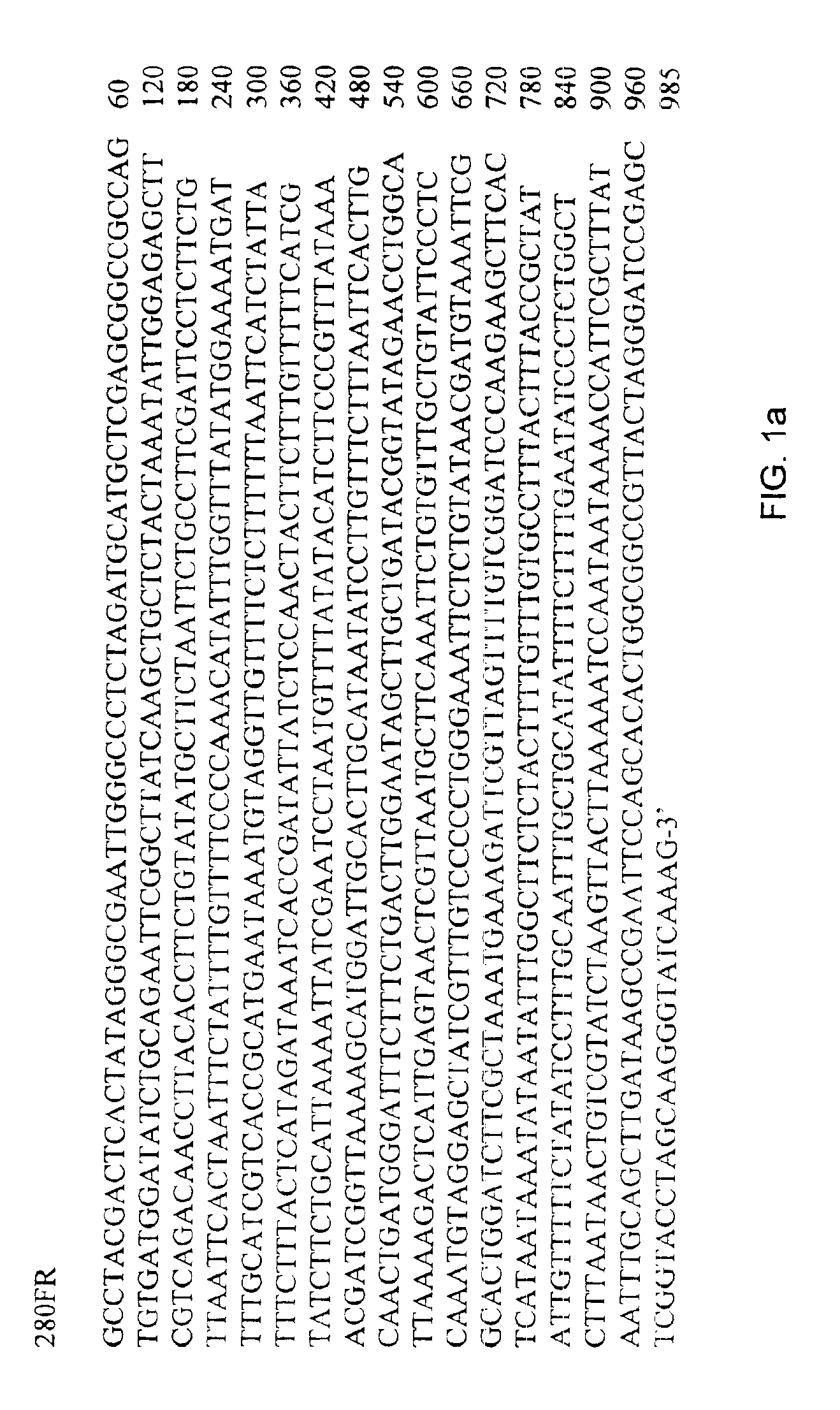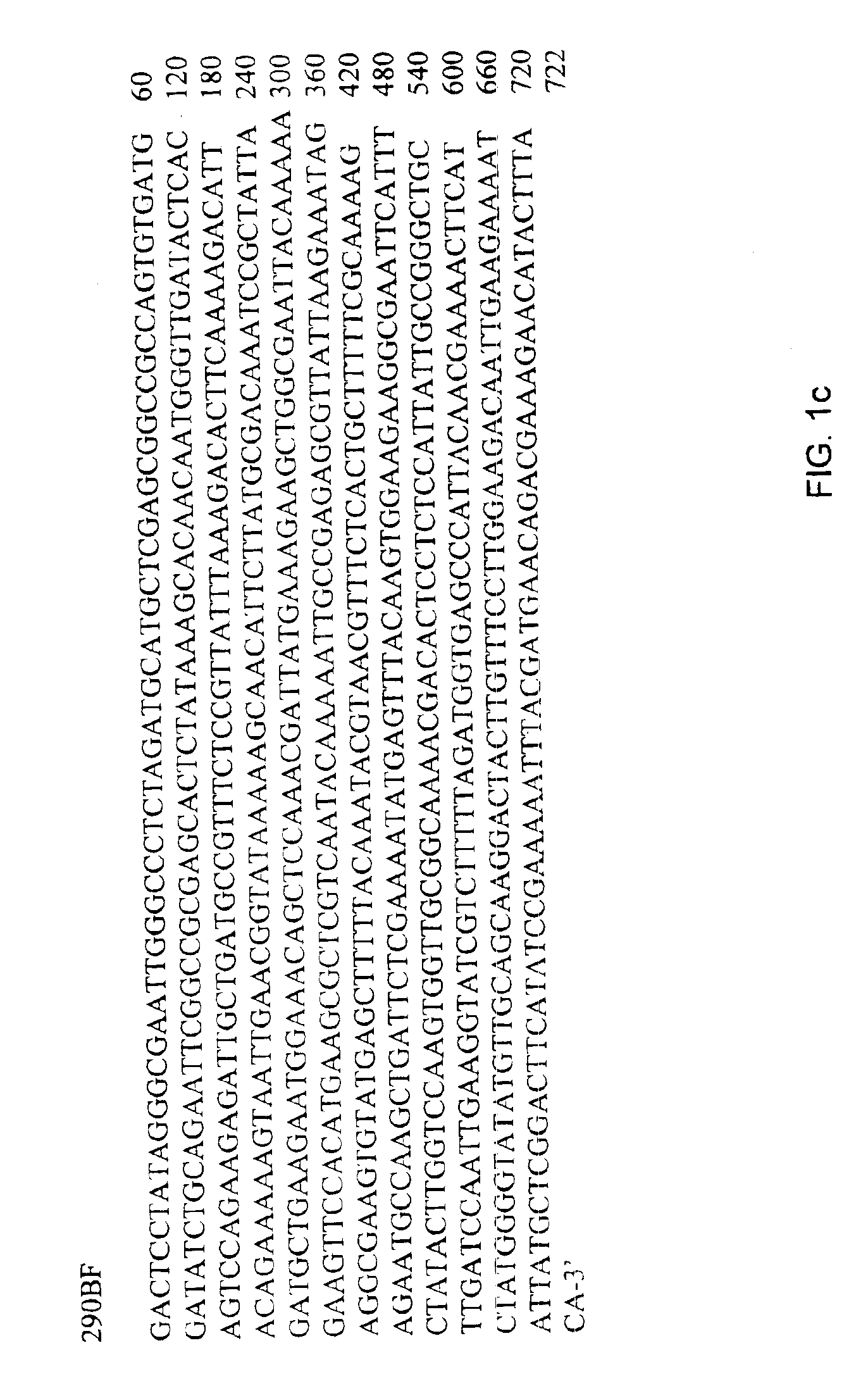Nucleotide sequences for detection of Bacillus anthracis
a technology of bacillus anthracis and nucleotide sequences, which is applied in the field of nucleotide sequences for detection of bacillus anthracis, can solve the problems of high fever and chest pain, gelatinous edema, and both types of cancer, and achieve sensitive and reliable detection, accurate analysis of samples for environmental contamination
- Summary
- Abstract
- Description
- Claims
- Application Information
AI Technical Summary
Benefits of technology
Problems solved by technology
Method used
Image
Examples
example 1
Amulification of Anthrax-specific DNA in Spiked Samples
[0070]The inventors herein have identified five random 10-mer primers, designated as 173, 248, 280, 290, and 361, result in amplification of DNA fragments from the chromosomal DNA of wild-type anthrax. These primers did not amplify the similar-sized DNA fragments from the genomic DNA from strains related to anthrax, i.e., B. cereus, B. thuringiensis, and an unrelated strain Agrobacterium tumifaciens (see FIGS. 2a through 3b). In addition, genomic DNA from wild-type anthrax and two derivative strains lacking one or both plasmids were used as target DNA. The fact that similar-sized DNA fragments are observed in the three anthrax strains, indicates that the priming sites must be located on the chromosome. The amplification pattern derived from A. tumifaciens DNA was very different from Bacillus DNA, and therefore, this DNA was not included in subsequent experiments.
[0071]As shown in FIG. 4, anthrax-specific fragments were amplified...
example 2
Assessing the Detection Limit
[0072]Spiked samples were prepared using 0.001, 0.01, 0.1 or 1 ng of anthrax DNA with 50 ng sludge DNA. These amplification assays were set up in an attempt to determine the detection limit of anthrax DNA in the presence of an overwhelming amount of non-specific background DNA. Typically, in RAPD assays, low stringency annealing conditions are used to allow priming event even if the primers are not fully complementary to the priming sites, i.e., a certain level of mis-match is allowed. In an effort to determine which primers are more specific to the priming sites, an annealing temperature of 52° C. was used to preclude priming events from mismatched sites. As shown in FIG. 5, primer nos. 173 and 280 were able to amplify at high-stringency temperature even in the presence of 0.001 ng (1 pg) control anthrax DNA. This result indicates that the PCR assay is highly sensitive for detection of anthrax DNA even in the presence of 5,000-fold excess of non-specifi...
example 3
Design and Use of High-fidelity Primers
[0073]High-fidelity forward and reverse primer sets (15-20-bases in length) were designed based on the sequence of the cloned regions. Six sets of primers, F1-B11 (290R), F1-B20 (290F), F2-B12 (280R), F1-B22 (173R), F1-B17 (290F), and F1-B2 (248F) were selected to amplify fragments ranging in length from 144-520 bp. Total DNA isolated from environmental sources, soil and sludge, was spiked with anthrax DNA. Control DNA samples contained 1.65-1.85 ng non-specific DNA and spiked samples contained 1 pg of anthrax DNA. The ratio of non-specific DNA: anthrax DNA was about 1,600:1. As shown in FIG. 6, except for the primer set combination F1-B2, the other five primer sets amplified expected fragments in spiked soil / sludge samples. This result demonstrates that even in the presence of overwhelming non-specific DNA, the designed high-fidelity primers of the invention amplify anthrax-specific fragments.
PUM
| Property | Measurement | Unit |
|---|---|---|
| concentration | aaaaa | aaaaa |
| volume | aaaaa | aaaaa |
| volume | aaaaa | aaaaa |
Abstract
Description
Claims
Application Information
 Login to View More
Login to View More - R&D
- Intellectual Property
- Life Sciences
- Materials
- Tech Scout
- Unparalleled Data Quality
- Higher Quality Content
- 60% Fewer Hallucinations
Browse by: Latest US Patents, China's latest patents, Technical Efficacy Thesaurus, Application Domain, Technology Topic, Popular Technical Reports.
© 2025 PatSnap. All rights reserved.Legal|Privacy policy|Modern Slavery Act Transparency Statement|Sitemap|About US| Contact US: help@patsnap.com



